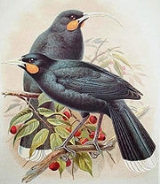
Callaeidae
Encyclopedia
The small bird family Callaeidae (also named in some sources as Callaeatidae) is endemic to New Zealand
. It contains three monotypic
genera; of the three species in the family, only two survive and both of them, the Kokako
and the Saddleback
, are endangered species, threatened primarily by the predations of introduced mammalian species such as rats, mustelids and possums. A third, the Huia
became extinct early in the 20th century.
The Callaeidae are often known as wattlebirds, a term that leads to confusion, as there are other, unrelated species with this same name, notably the large Australian wattlebirds of the family Meliphagidae, which are honeyeaters. For this reason New Zealand wattlebirds is the informal name for this family used by the scientific community.
s behind the bill. Their wings are rounded and unusually weak, giving them very limited powers of flight. They are monogamous and maintain permanent territories.
These birds seem to be remnants of an early expansion of passerines to New Zealand. They have no close relatives except the stitchbird
, and their more distant relationships are likewise still unknown.
A molecular study of the nuclear RAG-1 and c-mos genes of the three species within the family proved inconclusive, the data providing most support for either a basally diverging Kokako or Huia.
New Zealand
New Zealand is an island country in the south-western Pacific Ocean comprising two main landmasses and numerous smaller islands. The country is situated some east of Australia across the Tasman Sea, and roughly south of the Pacific island nations of New Caledonia, Fiji, and Tonga...
. It contains three monotypic
Monotypic
In biology, a monotypic taxon is a taxonomic group with only one biological type. The term's usage differs slightly between botany and zoology. The term monotypic has a separate use in conservation biology, monotypic habitat, regarding species habitat conversion eliminating biodiversity and...
genera; of the three species in the family, only two survive and both of them, the Kokako
Kokako
The Kōkako is a forest bird which is endemic to New Zealand. It is slate-grey with wattles and a black mask. It is one of three species of New Zealand Wattlebird, the other two being the endangered Tieke and the extinct Huia...
and the Saddleback
Saddleback
In general, a saddleback is the shape of a saddle.Saddleback can also refer to:Fauna* Saddleback , an endemic bird in New Zealand.* Saddleback caterpillar, a moth larva with a painful sting* Saddleback clownfish* Saddleback toad...
, are endangered species, threatened primarily by the predations of introduced mammalian species such as rats, mustelids and possums. A third, the Huia
Huia
The Huia was the largest species of New Zealand wattlebird and was endemic to the North Island of New Zealand. Its extinction in the early 20th century had two primary causes. The first was rampant overhunting to procure Huia skins for mounted specimens, which were in worldwide demand by...
became extinct early in the 20th century.
The Callaeidae are often known as wattlebirds, a term that leads to confusion, as there are other, unrelated species with this same name, notably the large Australian wattlebirds of the family Meliphagidae, which are honeyeaters. For this reason New Zealand wattlebirds is the informal name for this family used by the scientific community.
Biology and evolution
The two surviving species are ground-dwelling songbirds, 26–38 cm in length. They inhabit dense forests, where they feed on insects. They have strong legs and featherless wattleWattle (anatomy)
A wattle is a fleshy dewlap or caruncle hanging from various parts of the head or neck in several groups of birds, goats and other animals. In some birds the caruncle is erectile tissue.The wattle is frequently an organ of sexual dimorphism...
s behind the bill. Their wings are rounded and unusually weak, giving them very limited powers of flight. They are monogamous and maintain permanent territories.
These birds seem to be remnants of an early expansion of passerines to New Zealand. They have no close relatives except the stitchbird
Stitchbird
The Stitchbird or Hihi is a rare honeyeater-like bird endemic to the North Island and adjacent offshore islands of New Zealand. It became extirpated everywhere except Little Barrier Island but has been reintroduced to three other island sanctuaries and two locations on the North Island mainland...
, and their more distant relationships are likewise still unknown.
A molecular study of the nuclear RAG-1 and c-mos genes of the three species within the family proved inconclusive, the data providing most support for either a basally diverging Kokako or Huia.

